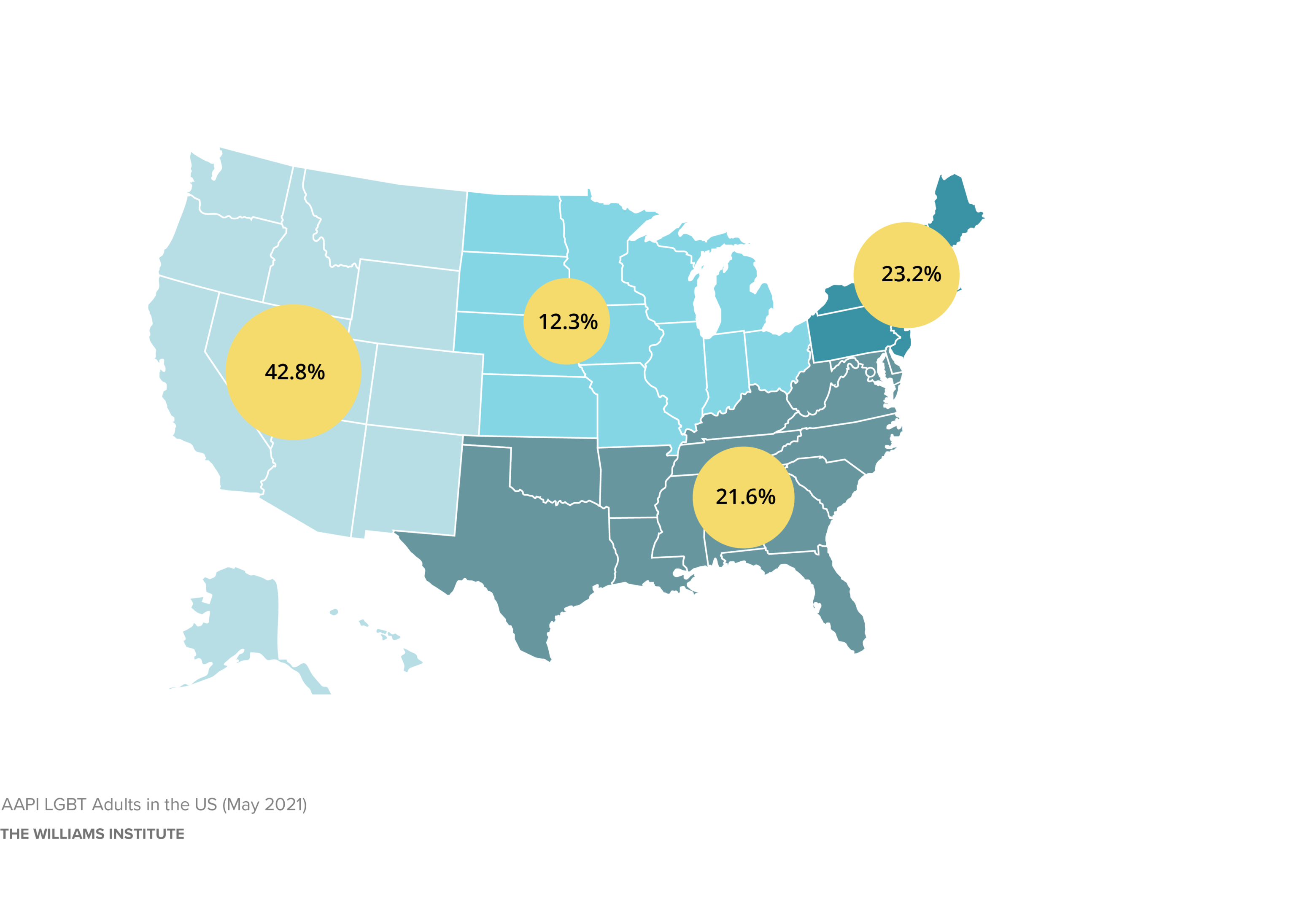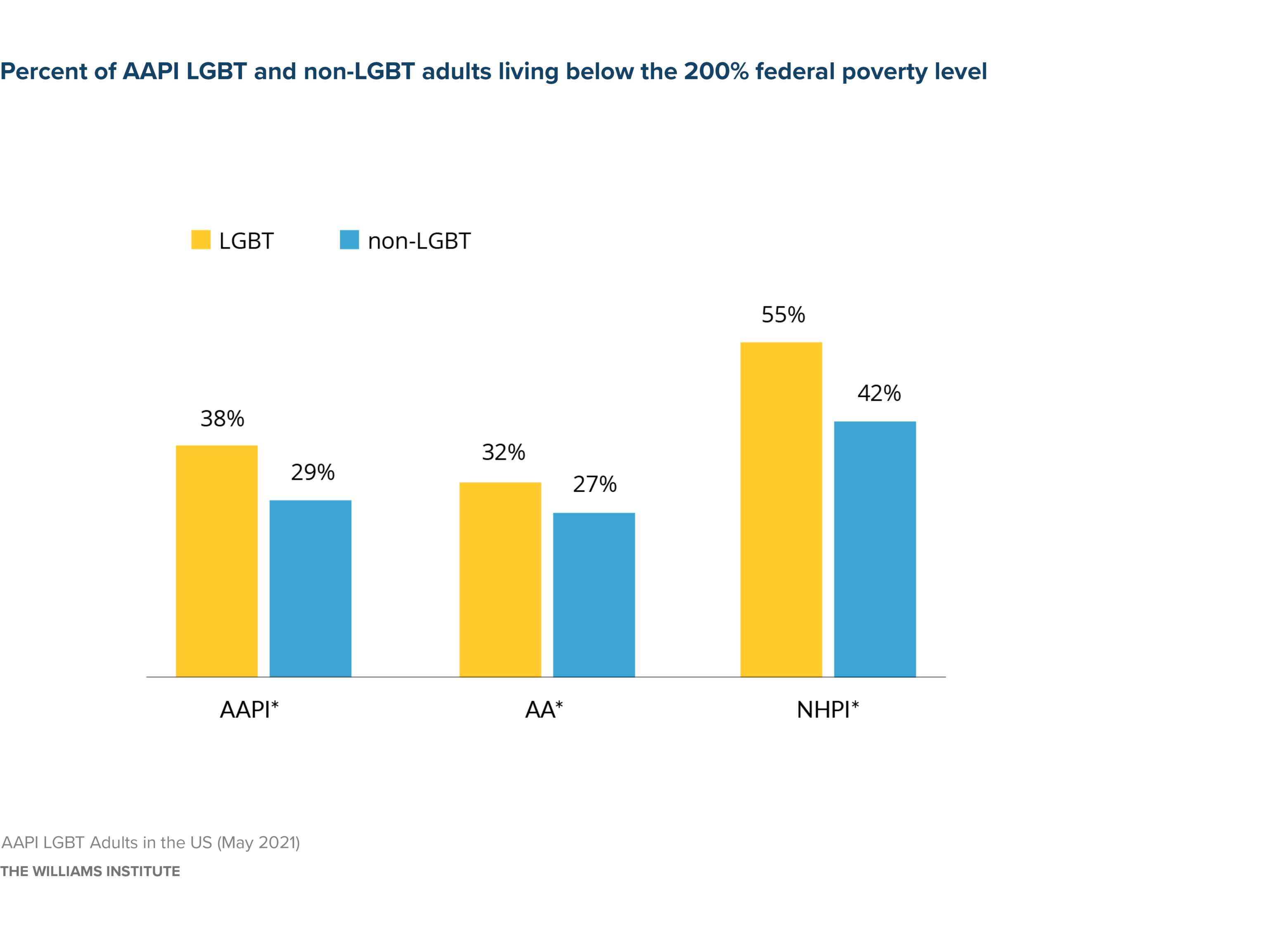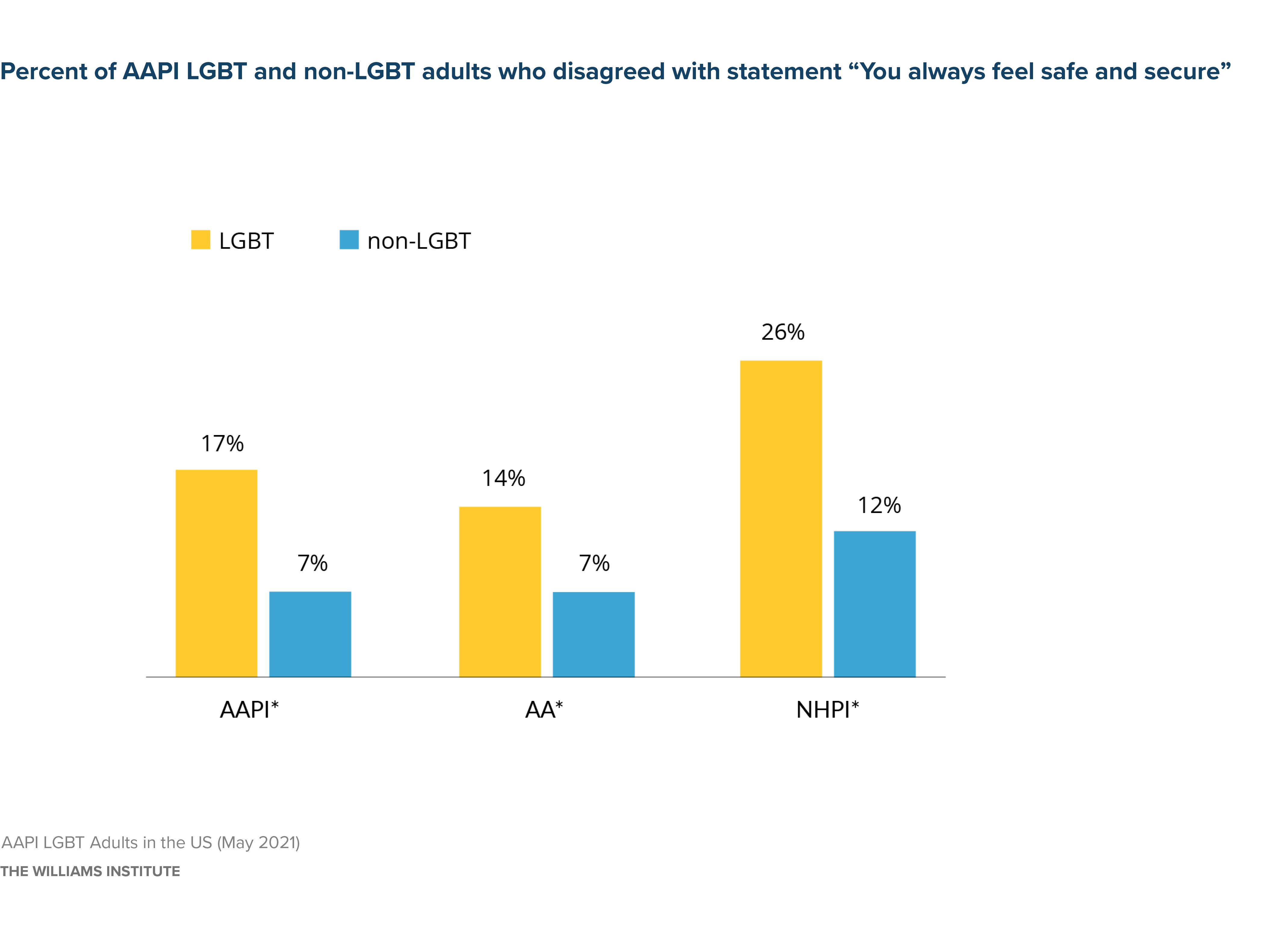Executive Summary
Over 11.3 million LGBT adults live in the U.S. They are a part of every community throughout the country and are diverse in terms of personal characteristics, socioeconomic outcomes, health status, and lived experiences. In many ways, LGBT people are similar to their non-LGBT counterparts, but also show differences that illuminate their unique needs and experiences related to sexual orientation and gender identity.
About 40% of LGBT adults are people of color, including 3% who identify as Asian American or Pacific Islander (AAPI). In this report, we analyzed data from several sources to provide information about adults who self-identify as AAPI and LGBT. We present an overview of their demographic characteristics and focus on several key domains of well-being, including mental health, physical health, economic health, and social and cultural experiences. In addition, we compared AAPI LGBT and non-LGBT adults across these indicators in order to explore differences related to sexual orientation and gender identity among AAPI Americans. For several key indicators, we also compared AAPI LGBT and non-LGBT women and AAPI LGBT and non-LGBT men in order to explore differences related to gender. We analyzed outcomes for Asian and Asian American (AA) LGBT people and Native Hawaiian and Pacific Islander (NHPI) LGBT people separately when it was possible based on available data.
This report is part of a larger series, LGBT Well-Being at the Intersection of Race, which provides the same information for each racial/ethnic minority group in the U.S. A final comparative report examines differences across racial groups among LGBT people.
Key Findings
Demographic characteristics
An estimated 685,000 U.S. adults self-identify as AAPI and LGBT. Among all AAPI adults, 4.5% identify as LGBT, including 3.8% of AA adults and 8.8% of NHPI adults.
AAPI LGBT adults are more likely to live in the West than in other regions: 43% of AAPI LGBT adults live in the West, compared to 23% in the Northeast, 22% in the South, and 12% in the Midwest.
Mental and physical health
- Overall and across subgroups, AAPI LGBT and non-LGBT adults are similar in terms of reporting fair or poor overall health: 16% of AAPI LGBT adults and 12% of AAPI non-LGBT adults report that their health is fair or poor. However, more NHPI adults, both LGBT and non-LGBT, report having fair or poor health compared to AA adults. Additionally, AAPI LGBT women (17%) are more likely to report fair or poor health than non-LGBT women (12%), however, the difference is driven by the high proportion of NHPI women reporting fair or poor health (29%).
- Over one-fifth (21%) of AAPI LGBT adults have been diagnosed with depression compared to 7% of AAPI non-LGBT adults. Among women, 30% of AAPI LGBT women (and 30% of both AA and NHPI LGBT women) have been diagnosed with depression compared to 9% of all AAPI non-LGBT women, 9% of AA non-LGBT women, and 14% NHPI non-LGBT women.
- AAPI LGBT adults are more likely to engage in high-risk health behaviors than AAPI non-LGBT adults. Among AAPI LGBT adults, 21% report current smoking and 7% report heavy drinking compared to 11% and 2% of AAPI non-LGBT adults, respectively. Rates of high-risk behaviors are particularly high for NHPI adults: 36% of NHPI LGBT adults and 23% of NHPI non-LGBT adults report smoking and 16% of NHPI LGBT adults and 5% of NHPI non-LGBT adults report heavy drinking.
- Overall, more AAPI LGBT than non-LGBT adults report levels of mild or high disability, defined by number of days that respondents experienced limitations due to poor health in the prior month. Among NHPI adults, LGBT men (31%) were more likely to experience mild disability (defined as experiencing limitations because of poor health for 1-14 days in the past month) than NHPI non-LGBT men (17%).
- AAPI LGBT adults had greater odds of being diagnosed with several serious health conditions including asthma, diabetes, cancer, and high blood pressure compared to AAPI non-LGBT adults. However, these differences were primarily driven by the higher prevalence of these conditions among NHPI LGBT adults.
Access to health care
- AAPI LGBT adults are more likely to lack health insurance than AAPI non-LGBT adults: 13% of AAPI LGBT adults are uninsured compared to 10% of AAPI non-LGBT adults.
- AAPI LGBT adults (9%) are more likely to have Medicaid as their primary insurance than AAPI non-LGBT adults (4%). Among women, 8% of AA LGBT women and 20% of NHPI women are enrolled in Medicaid compared to 4% of AA non-LGBT women and 10% of NHPI non-LGBT women.
- AAPI LGBT parents are more likely to be enrolled in Medicaid than AAPI non-LGBT adults: 12% of AAPI LGBT adults, including 17% of women, raising children are enrolled in Medicaid compared to 5% of AAPI non-LGBT adults, including 6% of women.
- Close to two-thirds of AAPI LGBT adults (63%) and AAPI non-LGBT adults (67%) have a personal doctor. However, NHPI LGBT adults (59%) are less likely to have a personal doctor than NHPI non-LGBT adults (69%).
Discrimination and stressful events
- AAPI LGBT adults more likely to say they feel unsafe than AAPI non-LGBT adults: 17% of AAPI LGBT adults said that they disagreed with the statement “You always feel safe and secure” compared to 7% of AAPI non-LGBT adults. Rates of feeling unsafe were particularly high for NHPI LGBT adults (26%) and NHPI non-LGBT adults (12%).
- Many AAPI transgender adults reported experiences of discrimination and victimization. Seventy-one percent of AAPI transgender adults reported experiences of everyday discrimination (such as being treated with less courtesy than other people), 56% reported experiencing physical assault and threats, and 63% reported experiencing verbal assault or abuse. Similar data are not available for AAPI cisgender LGB and non-LGB people.
- Many AAPI transgender adults also reported financial and job-related stress: 80% reported chronic financial and job-related stress, 28% reported being fired from or denied a job, and 23% reported receiving a negative review or being denied a promotion at work. Similar data are not available for AAPI cisgender LGB and non-LGB people.
Resiliency
- The majority (78%) of AAPI transgender adults reported feeling connected to the transgender community.
- Less than half (41%) of AAPI transgender adults reported feeling connected to the AAPI community.
- Around half of AAPI transgender adults reported they felt supported through their social circles and felt a sense of social well-being.
- Data on indicators of resilience are not available for AAPI cisgender LGB and non-LGB people.
In addition to presenting national data, we compared AAPI LGBT and non-LGBT adults on several key outcomes by region in the U.S.: West, Northeast, South, and the Midwest. Overall, patterns identified within each region reflect what we found across the U.S. Full details on the regional analyses can be found on page 39 of the report.
Download the full report
Download the executive summary in Chinese
Download the executive summary in Korean
Download the executive summary in Vietnamese
Download the executive summary in Tagalog



